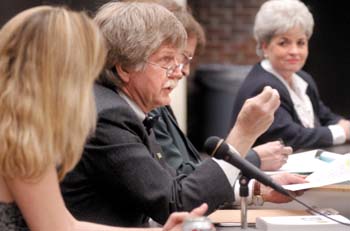
Dr. John Tarpley makes a point at the Ethics Grand Rounds regarding cultural disparities in medical treatment. Also on the panel were, from left, Lori Cabbage, Carter Moody, and Jean Gauld-Jaeger. (photo by Dana Johnson)
Cultural barriers can affect health care: panel
As the demographics of the United States have changed over the past decade, so has the patient population of Vanderbilt University Medical Center.
In addition to a large Hispanic population, Nashville has the largest population of Kurds in the United States (about 5,000), 1,800 to 2,200 Somalians, and a significant number of Sudanese. These statistics were presented by Carter Moody of Nashville’s Task Force on Refugees and Immigrants at Tuesday’s Ethics Grand Rounds. The title of the session was “Does Difference Matter? Culture, Ethnicity, Religion and Patient Preferences.”
Jean Gauld-Jaeger, director of Patient Affairs, said the Medical Center began offering interpreter services in 1993 when there became an increased need. They subscribed to the Language Line, a telephone interpreter service, and there were 156 requests that year. It cost the Medical Center $4,088.
In 2000, after a review by the Office of Civil Rights, it became necessary to expand the interpretation services. In 2001, the requests for interpreters through Language Line rose to 1,093 at a cost of $22,398 for the Medical Center. The total number of requests, through both Language Line and on-site volunteer and contract interpreters, was 2,030. In March 2001, the Medical Center hired Johannie Resto as coordinator of Interpreter Services.
Gauld-Jaeger said that interpreters must be able to communicate effectively with both the patient and his or her family; to explain procedures, diagnoses, discharge instructions, specifics on follow-up appointments, financial concerns, and third-party reimbursement.
“And they have to understand cultural considerations, which sometimes may actually impede our ability to diagnose,” she said.
To help with the communication issue, the Medical Center offers Spanish language classes to those interested in learning and will soon begin offering medical terminology classes to volunteer interpreters, Gauld-Jaeger said.
Patient Affairs must also try to determine an interpreter’s competence when a family brings their own interpreter to the hospital.
This became increasingly apparent when a Bosnian woman suffered a serious stroke and was hospitalized at Vanderbilt University Hospital. The woman’s husband brought a friend who spoke some English to the hospital to translate what the doctor had to say, but it was apparent that the woman’s husband was perplexed and upset when he left the hospital, Gauld-Jaeger said.
“The husband understood his friend to say that he had to move his sick wife to a new hospital every two days,” Gauld-Jaeger said. “He went home, talked to his landlord and the landlord paged me. The doctor had actually told the husband that his wife was doing extremely well, that she would only need two more days in the ICU, then would be moved to a regular unit. It came out all scrambled and created a great deal of anxiety for this patient’s husband.”
Others participating in the ethics discussion were moderator Stuart G. Finder, Ph.D., director of the Center for Clinical and Research Ethics, Dr. John L. Tarpley, professor of Surgery, and Lori Cabbage, a nurse-midwife and family nurse practitioner at the Vine Hill Clinic.
Cabbage said it is becoming increasingly important to incorporate cultural diversity and ethnicity into the nursing and medical school curriculums, something that both Vanderbilt schools are doing.
Cabbage said that some women, under the care of nurse midwives, prefer women physicians due to cultural concerns. If it becomes necessary to seek the help of a physician, the Vine Hill practice tries to see that the women are hooked up with women residents or attendings at VUH.
“We have also learned that the use of touch is not acceptable in all cultures,” she said. “We need to evaluate what is acceptable for each woman.”













